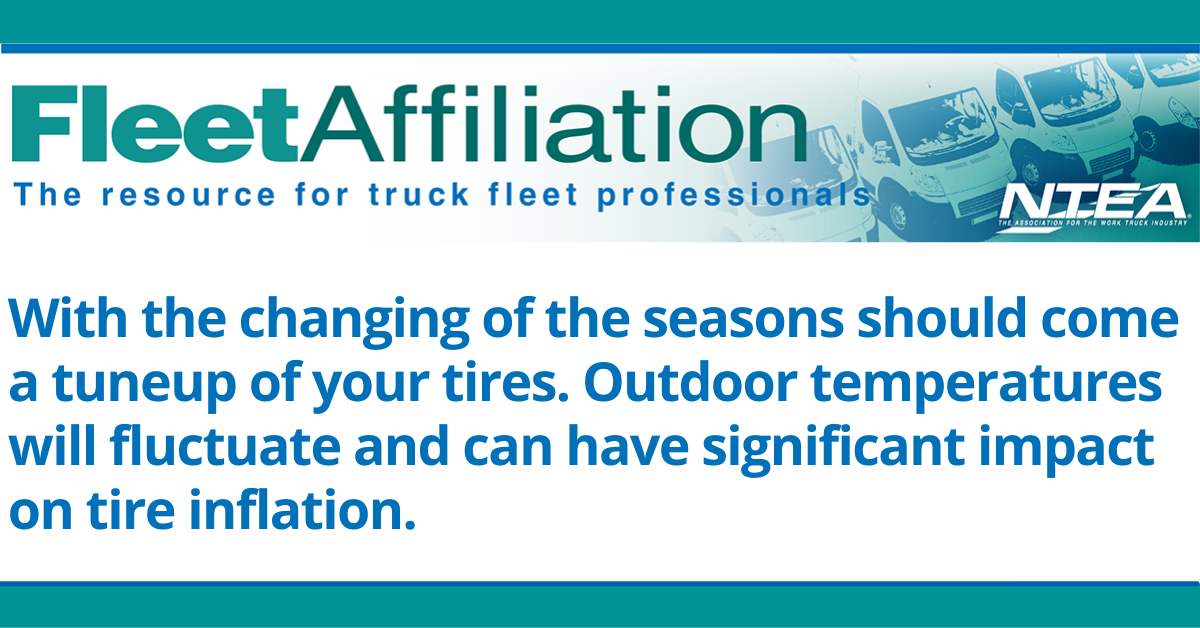
Published in May 2021 Fleet Affiliation
With the changing of the seasons should come a tuneup of your tires. Outdoor temperatures will fluctuate, and a change of 10 to 15 degrees can have significant impact on tire inflation, so it’s natural to check tire pressure. Unfortunately, you may be in more trouble than you realize if your organization only checks tire pressure with the changing of the seasons.
Within the fleet industry, it is widely recognized and accepted that proper tire inflation has a direct impact on your bottom line. Beyond the benefit of improved fuel economy, appropriately inflated tires optimizes tread wear and reduces long-term suspension and steering maintenance costs.
Seasoned fleet managers likely already know theory and practice can be two different things. To achieve both, it is important to be educated and equip operators with knowledge, and share the importance and the tools to maintain this relatively simple practice.
Empower the driver
Your operators are more than equipped to check and maintain air pressure; however, they may not see the end value in this task. Drivers may feel that this is the job for maintenance technicians, but this is not a realistic expectation. Your organization likely has far more vehicles than technicians, paired with operators trying to do their work.
However, operators should care about comfort and safety. So educate your drivers, beginning with the benefits that directly relate to them. Hit on comfort, which includes better ride and handling; this reduces driver fatigue. Safety is of utmost importance. Drivers operate these vehicles every day; speaking their language on traction and braking distances will definitely get their attention.
Keeping it simple
It is critical to keep the task simple; if checking and adjusting tires takes the operators more than a few minutes, chances are the task won’t be completed. Although it should be basic knowledge, a brief refresher course may go a long way.
For vehicles built after September 1, 2005, the recommended tire pressure can be found on the driver’s side “B post.” For vehicles manufactured prior to September 1, 2005, the inflation information can be found in one of several places including the glove box or on the edge of a door post. Your owner’s manual should have this information as well.
We said to keep it simple. Not all vehicles are created equal, especially those built in multiple stages. All tires, regardless of application, will have a maximum tire pressure rating. This does not mean that the user can fill the tires to this value and be good. For vehicles manufactured in multiple stages, proper tire pressure must be calculated based on actual tire load. The simplest way may be to work with your upfitter or final manufacturer to identify (and post) proper tire inflation.
Giving them the tools
To help operators maintain tire pressure, provide them with the right tools and the right information at a fingertip’s grasp. The most basic tool is of course a tire gauge. Be prepared to go through several gauges per vehicle in the beginning. Considering the cost of fuel and mitigation of risk, this is a small investment. Second, although most operators may know where to look for appropriate tire pressure specs, place a decal in easy view. Lastly, educate the operator on safety, comfort, and cost savings. Neglecting proper tire pressure results in higher fuel consumption and increased wear and maintenance, as well as risk exposure.
More fleet resources
Fleet certification opportunities
Fleet Affiliation
Fleet Advisory Council